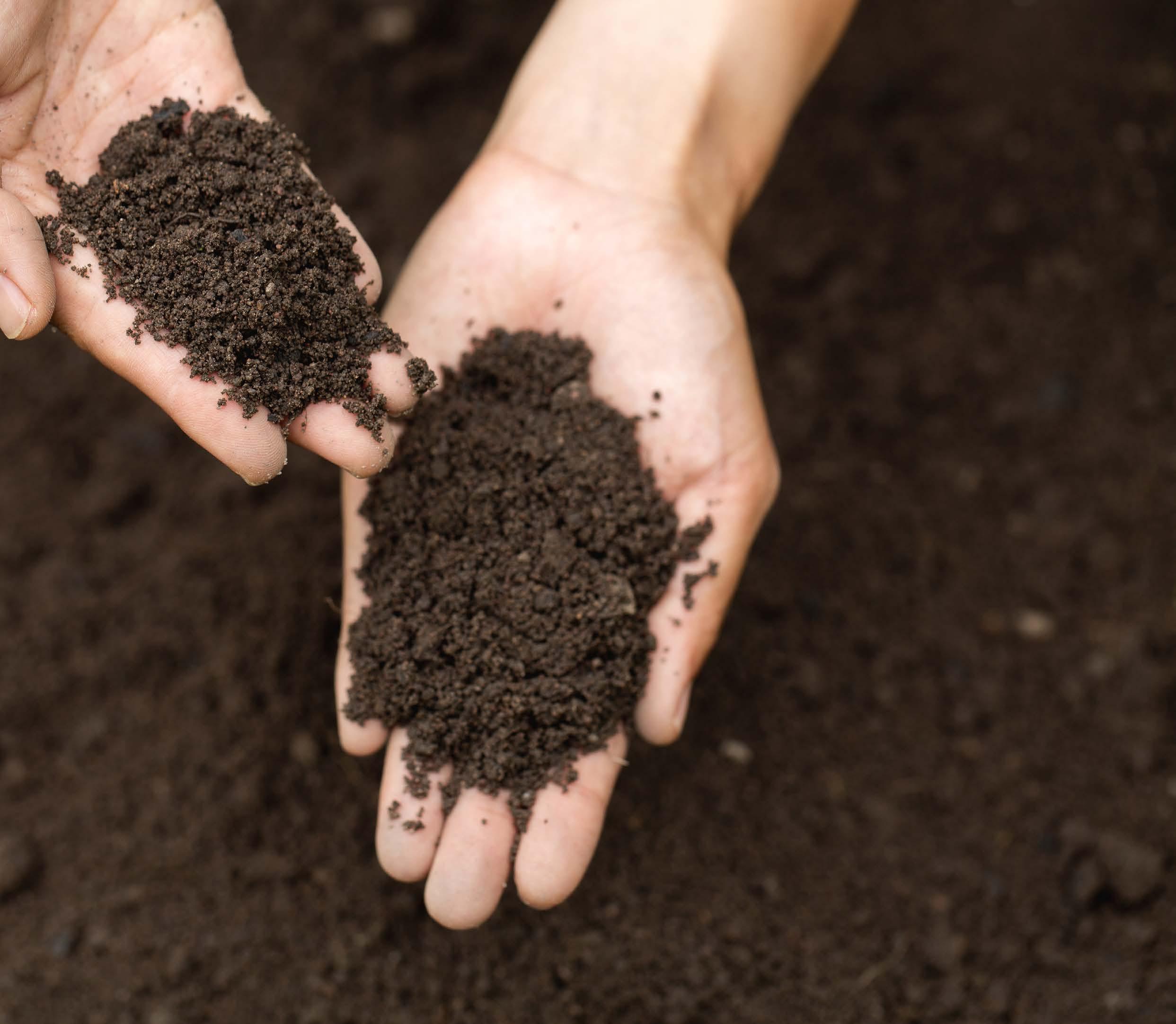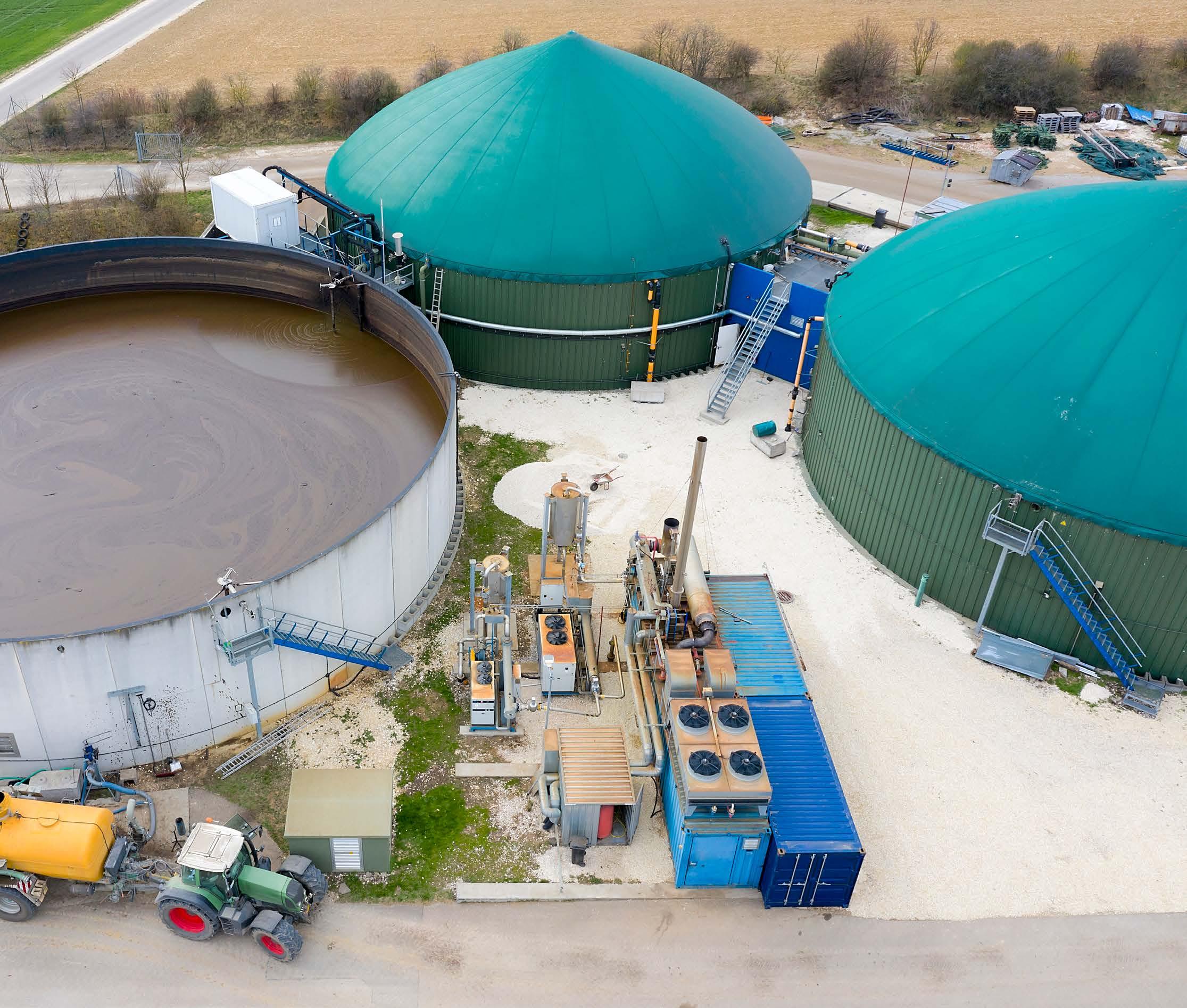
9 minute read
Biogas Digestate – BROWN GOLD
The properties and constituents of biogas plants digestate is determined essentially by the materials used as the substrates for the biogas digestion as well as by the digestion process itself. Treatment of animal manure and slurries within the biogas digester results in biodegradation of organic matter to inorganic compounds and biogas. In practice, the anaerobic degradation rate of organic matter from animal manure and slurries is about 40% - 50% for cattle slurry and of 65% - 70% for other animal manures. The degradation rate depends at large on feedstock type, HRT and process temperature. Due to degradation of organic matter, digestate is easier to pump and easier to apply as organic fertiliser, with reduced need of stirring, compared to untreated slurry.
Digestate Characteristics: As mentioned above the physio-chemical characteristics of digestate vary, strongly depending on the nature and composition of the feedstock used (it may also vary when the same feedstock is used and the characteristics are checked in different plants) as well as on the operational parameters of the biogas process. Researches done till date on digestates from biogas plants indicate that, when compared with raw animal manures and slurries, digestate generally has lower total solids (TS) and total organic carbon (C) content, lower carbon to nitrogen ratio (C:N), and lower viscosity. On the other hand, the pH value and the share of ammonium (NH 4 +) are higher in digestate compared to raw animal manures and slurries. Some characteristics relevant for the fertiliser quality of digestate can also be studied and discussed. In all most all the developing countries, the traditional substrates are agricultural/ livestock by-products (manure and slurries), biogen
ic waste (food waste, municipal organic waste, etc.), energy crops (maize whole crop silage, sugar beet, grass silage), by-products from food and agro-industries (animal by products from abattoirs, brewers’ spent grains and solubles, etc.). More recently, residues from the bioethanol and the biodiesel industries are used. Different substrate parameters as well as process parameters influence the composition of the digestate.
Importance of Digestate Quality and the Management of Quality: Digestate quality assurance means not only that digestate is safe for use but that it is also perceived as a safe product by farmers, food wholesalers, food retailers, decision makers and the general public. Improved confidence in the quality and safety of digestate is expected to lead to

its more widespread use as biofertilizer or organic manure. This should contribute to the development of a market for the quality certified products and support the further deployment of biogas technologies which provide important associated benefits to society. 1. Production of renewable gas i.e., Biogas/BioCBG, to displace use of fossil fuels 2. Displacement of mineral fertilisers, lowering their negative impact on the environment 3. Increased recycling of organic matter and nutrients and conservation of natural resources 4. Sanitation of organic wastes and animal manures, breaking the chain of pathogen transmission 5. Cost savings to farmers through enhanced use of own resources, reduced purchases of mineral fertiliser and higher nutrient efficiency
6. Potential for reduced air pollution from emissions of methane and ammonia through application of “good practices” 7. Contribution to food safety
The production and recycling of digestate as fertiliser/organic manure requires quality management and quality control throughout the whole closed cycle of biogas system, from the production of the biogas feedstock until the final utilisation of digestate as organic manure. Quality management implies the use of high-quality feedstock, pre-processing of specific feedstock types, close control of the biogas process and of process parameters affecting digestate quality, digestate processing, declaration and optimal storage and application as organic manure. The composition and quality of the digestate is determined by the composition and quality of the feedstock combined with the effectiveness of the biogas process. These are the two most critical factors that are important for the quality of digestate as organic fertiliser. Therefore, the main measure in digestate quality management is to ensure high feedstock quality. The materials used as feedstock should not only be easily digestible, but they must not be polluted by unwanted materials and compounds of chemical (organic and inorganic), physical or biological nature.
Enhancement of the Digestate: The paragraph describes the combination of treatment technologies/ techniques that have the potential to generate a number of complementary digestate “products”.
Slurry coming out of the digester is first dewatered to separate the liquid and solid fractions. The dewatered fibre can then be applied directly to land or utilised for energy recovery. The first stage of the liquid treatment process can be aerobic reduction of chemical oxygen demand (COD) within a membrane bioreactor (MBR). The process is configured such that no ammonia is oxidised.
Sludge generated by this MBR is recycled back to the digester. Effluent from the MBR is dosed with magnesium hydroxide to increase the pH and magnesium ion concentration, enabling struvite precipitation. Struvite is precipitated and extracted for use as an organic fertiliser. As equimolar amounts of ammonia and phosphate are used in struvite production, and digestate is relatively rich in ammonia, there remain significant quantities of ammonium within the digestate liquid. In order to recover this ammonium, the liquid is fed into an ammonia stripper; as the pH and temperature of the digestate have already been increased the conditions are more suitable for the stripping process. In addition, the risk of fouling within the ammonia stripping column is greatly reduced as the COD has already been removed by the MBR.


The stripping process recovers the ammonia as ammonium sulphate. Sulphuric acid and heat are used within the process. (heat energy is required which can be used from the CHP/Generator or biogas boiler which is used to generate heat for maintaining the digester temperature).
The treated liquid from the process can be reused as process water, used for irrigation or discharged to sewer once the pollution control board norms are met. Alternatively, an additional treatment stage can be added in the form of reverse osmosis (RO) to produce higher quality process water or enable direct discharge to a watercourse. Combining the individual process units into the treatment system above provides an integrated and holistic treatment process capable of producing both solid and liquid organic fertiliser products from biogas digestate. However, this system incorporates several complex subsystems that require careful integration and operation and of course the capital as well as the operational cost of the entire project will be increased. This is the system followed by most of the Biogas plants installed abroad.
Present Road Blocks for the Digestate Enhancement: Most of the large-scale biogas plants in India have solid liquid separators and they sell the solid as well as liquid fertilizers (after recirculation of the liquid to a certain extent). The use of digestate enhancement technologies faces a number of blockages in the India, preventing their widespread adoption. The most significant blockage is the present high cost of installation, as well as the operational costs associated with the technologies. This blockage is directly linked to the cost of alternative disposal arrangements such as landfill or energy recovery facilities. However, the relatively low value of biogas digestate products and the associated cost of developing outlets or markets for these products is also another blockage. It is imperative that the installation of a single digestate enhancement system does not frustrate, or in the extreme negate, subsequent treatment pro-
cess additions. However, the cost of installing a suite of totally integrated enhancement systems, presents a significant financial challenge that the sector is unlikely to be able to fund at this stage. A key step to overcoming these types of blockages is to raise awareness of the waste sector to enhancement technologies and techniques, to reduce costs and to emphasise the financial benefits of implementing enhancement systems to secure potential income from the biogas digestate. This research exercise has identified a range of potential techniques and methods for treating and enhancing digestates in India (thanks to Indian Biogas Association for working on this), these options will not be adopted until the business models exist that ensure that the financial investment is worthwhile. There is a need to raise awareness of potential improvements to biogas digestate and ensure that the Indian Biogas Industry is aware that there may be advantages in developing flexible sites where changes can be adopted as new technologies become available.
Final Comments: Without any doubt biogas digestate has huge potential in India, still utilisation of digestate as organic manure is limited in India due to lack of information about its qualities and fear of potential risks related to its use and finally due to cost when compared with chemical fertilizers. The quality management of digestate not only guarantees that digestate is safe for use, but also contributes to the perception of digestate as a safe and healthy product. The aim of any entrepreneur establishing the biogas plant should be to enhance digestate and sell as organic manure. The quality management of digestate is part of the overall demand for quality products in agricultural field. The requirement for quality necessarily implies adoption of a unified approach herewith and of a system of quality parameters to measure and guarantee quality. I request Indian Biogas Association to look into the proper framework and quality standards for digestate and contribute to a sound and stable market for biogas digestate in India. Regulations which have been introduced by an increasing number of countries, include standards of biogas digestate quality, digestate certification schemes, guidelines for recommended practices for biogas digestate utilisation and positive lists of materials suitable for use as biogas feedstock. This type of selection and strict quality control of the materials used as feedstock for biogas is the first and most important step of digestate quality management ensuring maximum ecological and economic benefits from use of biogas digestate as organic manure. Digestate processing involves the application of a range of possible technologies to biogas digestate, comparable to the existing technologies for manure processing, sewage sludge treatment, and, in some cases, for wastewater treatment. The last decades have seen a trend of increased emphasis on improved sustainability in agriculture and preservation of natural resources like minerals phosphorus and potassium, consequently changing the focus of digestate processing from nutrient removal and disposal towards integrated nutrient recovery and recycling. This trend needs to be continued. Digestate processing, (which can be described in a separate article) can be partial, usually targeting volume reduction and separation of digestate into a liquid and a solid fraction, or it can be complete, refining digestate to for example pure water, a solid organic manure fraction and liquid concentrates. The first step in digestate processing is to separate the solid from the liquid. The solid fraction, often rich in phosphorus, can subsequently be directly applied as organic manure or biofertilizer in agriculture or it can be composted or dried for intermediate storage and feasible long-range transport. In conclusion, a wide range of technologies and techniques are available to create many innovative digestate products. However, operational experience of the technologies in the India is currently limited and, in many cases, direct land application is likely to remain the most economic option. Operational experiences should be sought from the countries where systems have been installed and biogas digestate products created to satisfy outlet demand.
Srinivas Kasulla
Independent Energy Consultant








